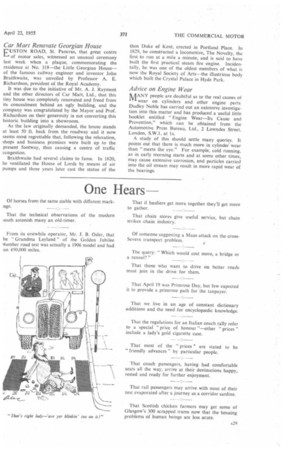Passing Comments
Page 30

Page 31

If you've noticed an error in this article please click here to report it so we can fix it.
Protecting Engines With Aluminium
JHE research laboratories of General Motors have developed a new technique of aluminium coating certain parts of engines which is claimed greatly to lengthen their life. The process is named the Aldip and is designed to protect steel parts against oxidation and corrosion, especially at high temperatures. It can be applied to exhaust and inlet manifolds, poppet valves, heat exchangers and components for gas turbines.
In a report presented before the Society of Automotive Engineers, two general methods of application are described. The original one, especially adapted for parts of intricate shape, is to pre-heat them in a patented salt flux and then dip them in molten A28 aluminium. The excess of the latter is blown, spun or shaken off.
In the newer method, the aluminium is sprayed on the steel part, this is then heated in the flux bath until the aluminium melts.
Road tests are said to have shown that Aldip valves last twice as long as uncoated valves of the same quality of steel. The secret of this protection is said to be the formation of alt iron-aluminium-alloy layer just beneath the surface.
In some stringent tests on lorries, four plain valves failed, but not one that was coated.
The process is being developed under licence by Thompson Products Inc. and the Rich Manufacturing Corp.
Car Mart Renovate Georgian House
pUSTON ROAD, St. Pancras, that great centre
of motor sales, witnessed an unusual ceremony last week when a plaque, commemorating the residence at No. 318—the Little Georgian House— of the famous railway engineer and inventor John Braithwaite, was unveiled by Professor A. E. Richardson, president of the Royal Academy.
It was due to the initiative of Mr. A. J. Rayment and the other directors of Car Mart, Ltd., that this tiny house was completely renovated and freed from its concealment behind an ugly building, and the company was congratulated by the Mayor and Prof. Richardson on their generosity in not converting this historic building into a showroom.
As the law originally demanded, the house stands at least 50 ft. back from the roadway and it now seems most regrettable that, following the relaxation, shops and business premises were built up to the present footway, thus causing a centre of traffic congestion.
Braithwaite had several claims to fame_ In 1820, he ventilated the House of Lords by means of air pumps and three years later cast the statue of the then Duke of Kent, erected in Portland Place. In 1829, he constructed a locomotive, The Novelty, the first to run at a mile a minute, and is said to have built the first practical steam fire engine. Incidentally, he was one of the oldest members of what is now the Royal Society of Arts—the illustrious body which built the Crystal Palace in Hyde Park.
Advice on Engine Wear
MANY people are doubtful as to the real causes of wear on cylinders and other engine parts Dudley Noble has carried out an extensive investigation into this matter and has produced a useful little booklet entitled "Engine Wear—Its Cause and Prevention," which can be obtained from the Automotive Press Bureau, Ltd., 2 Lowndes Street, London, S.W.1, at is.
A study of this should settle many queries. It points out that there is much more in cylinder wear than "meets the eye." For example, cold running, as in early morning starts and at some other times, may cause extensive corrosion, and particles carried into the oil stream may result in more rapid wear of the bearings.




























































































